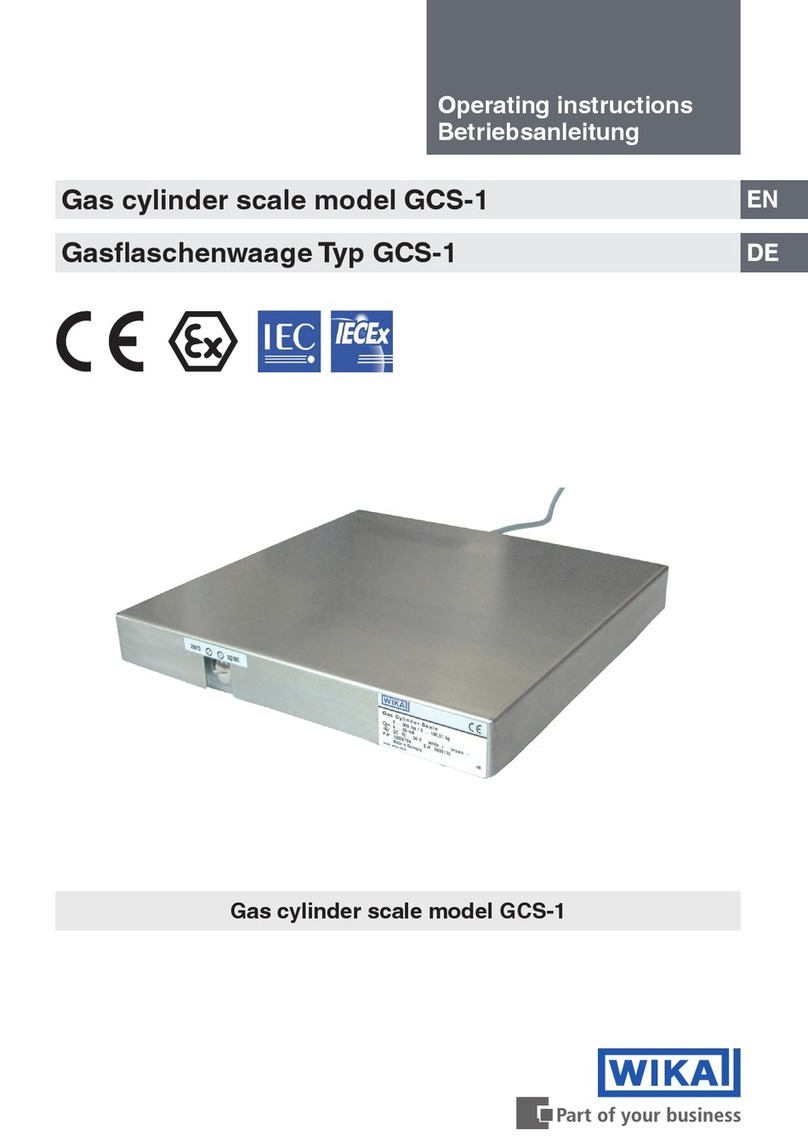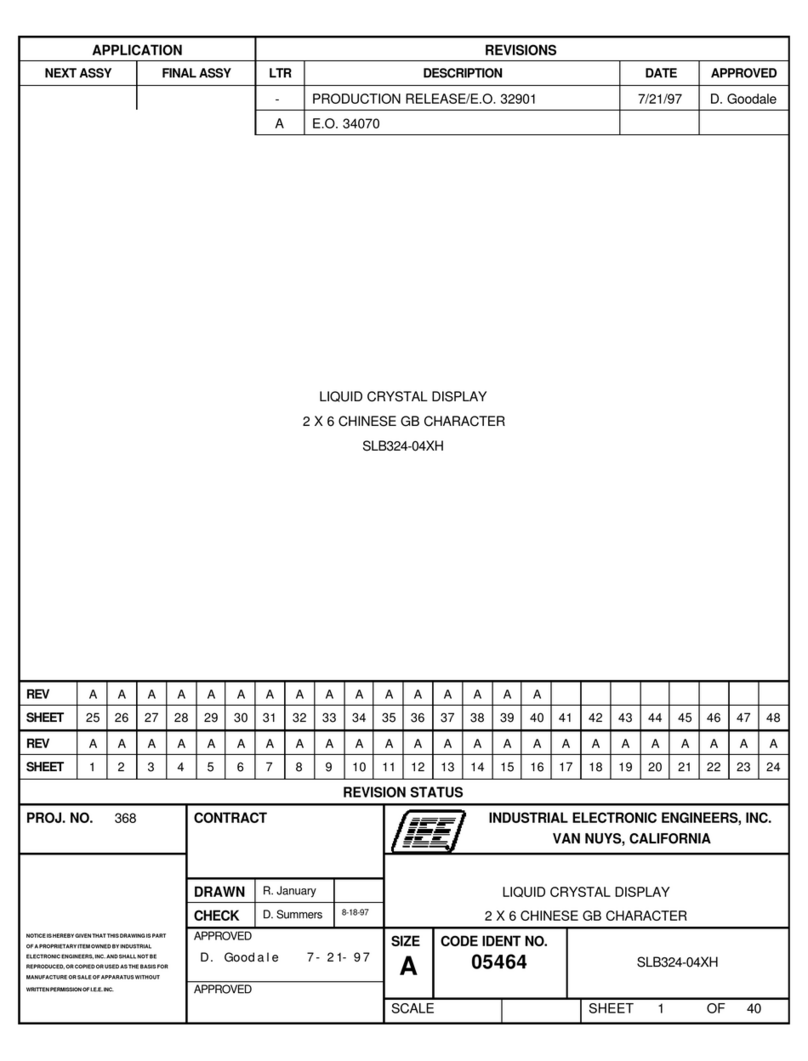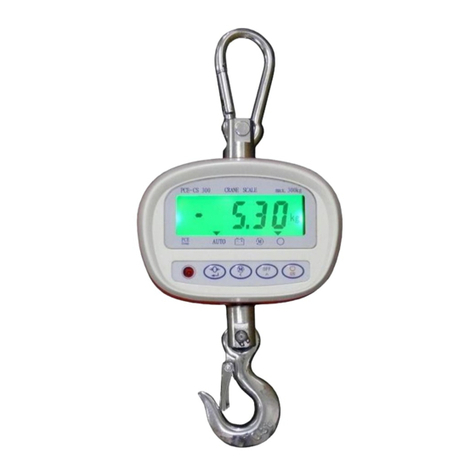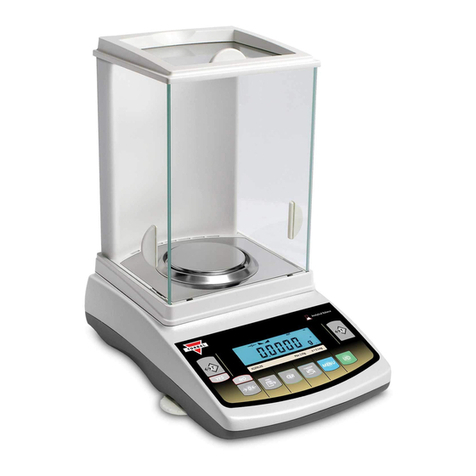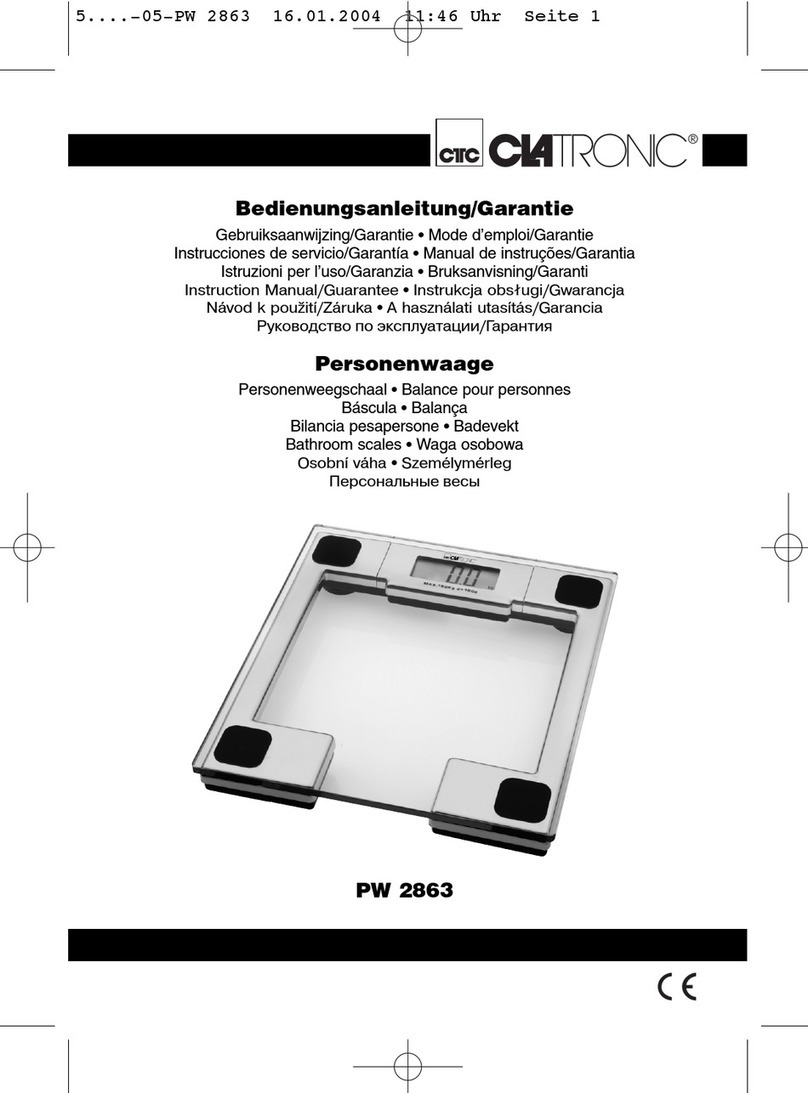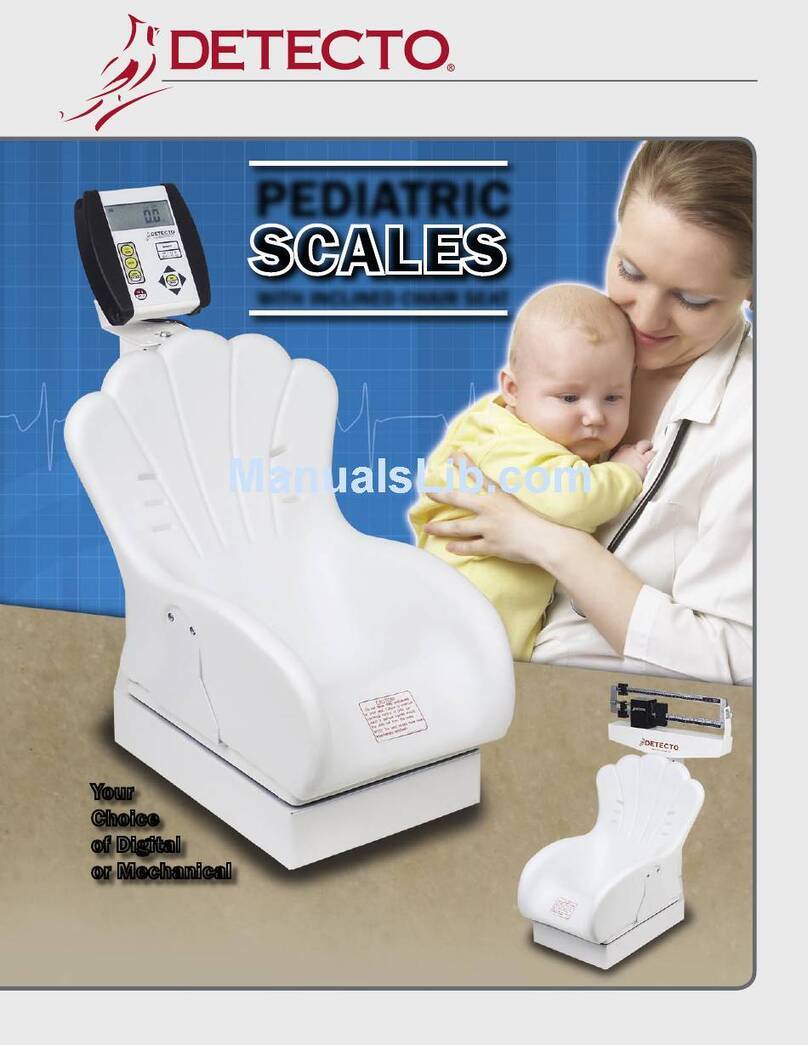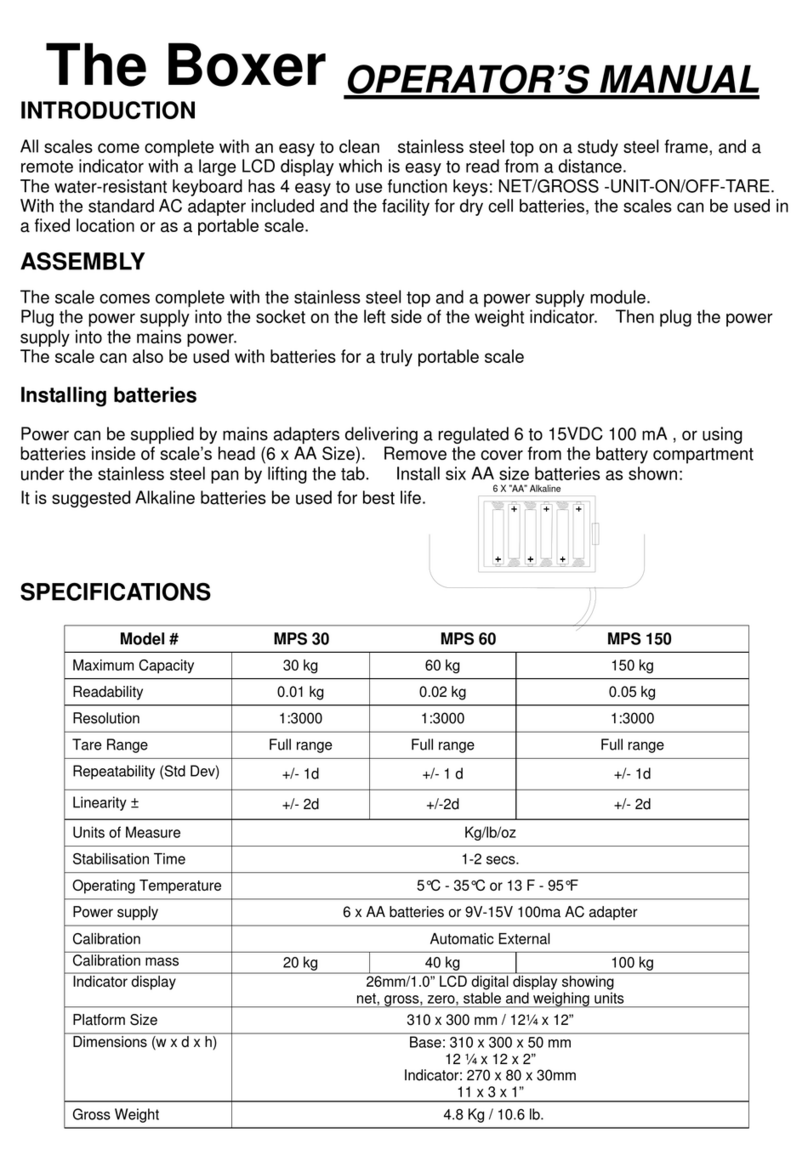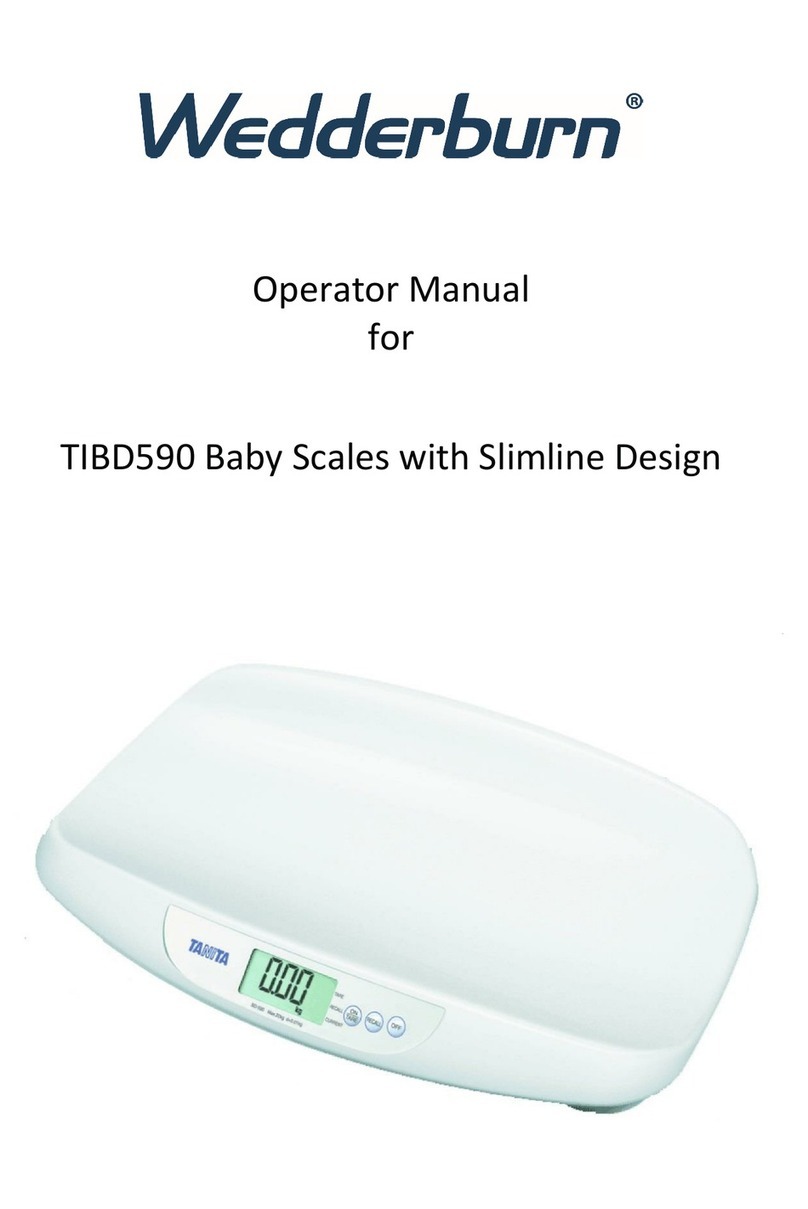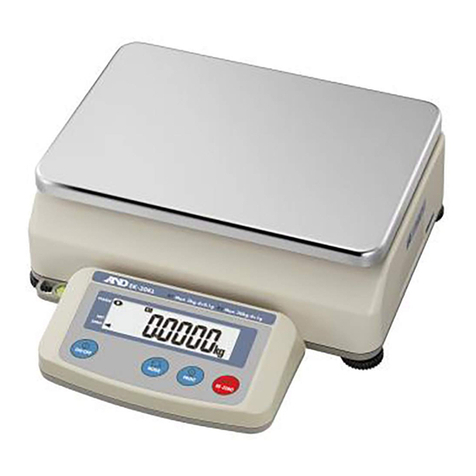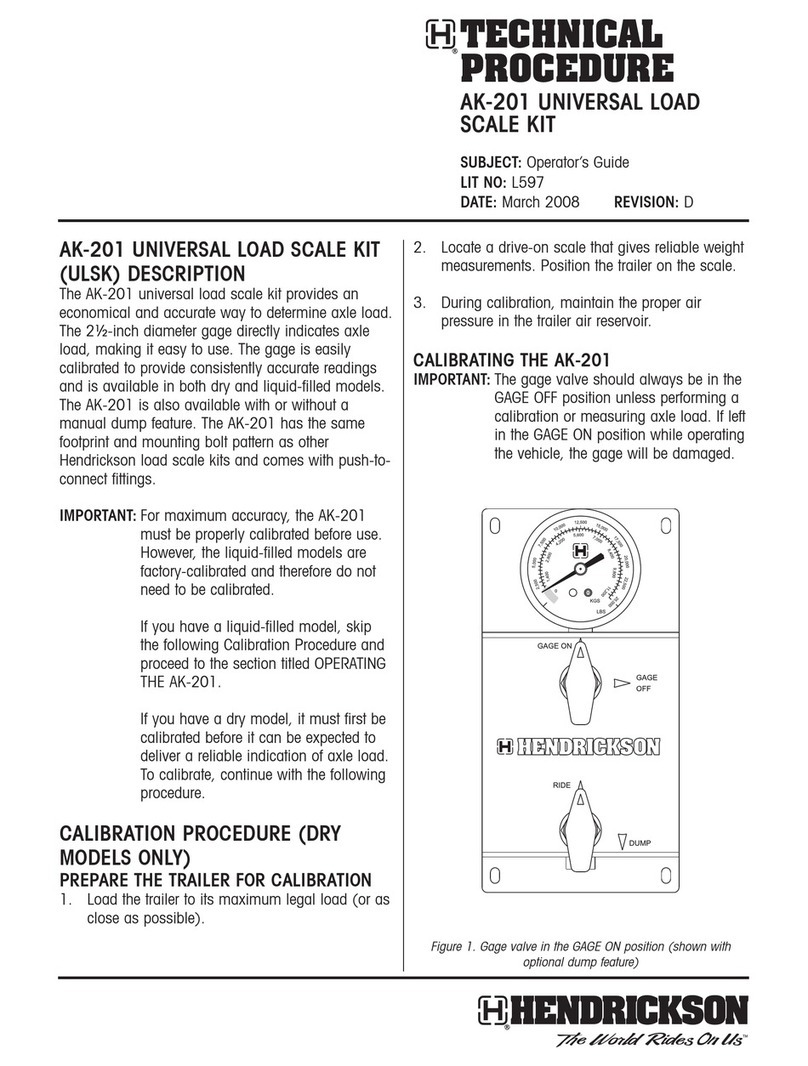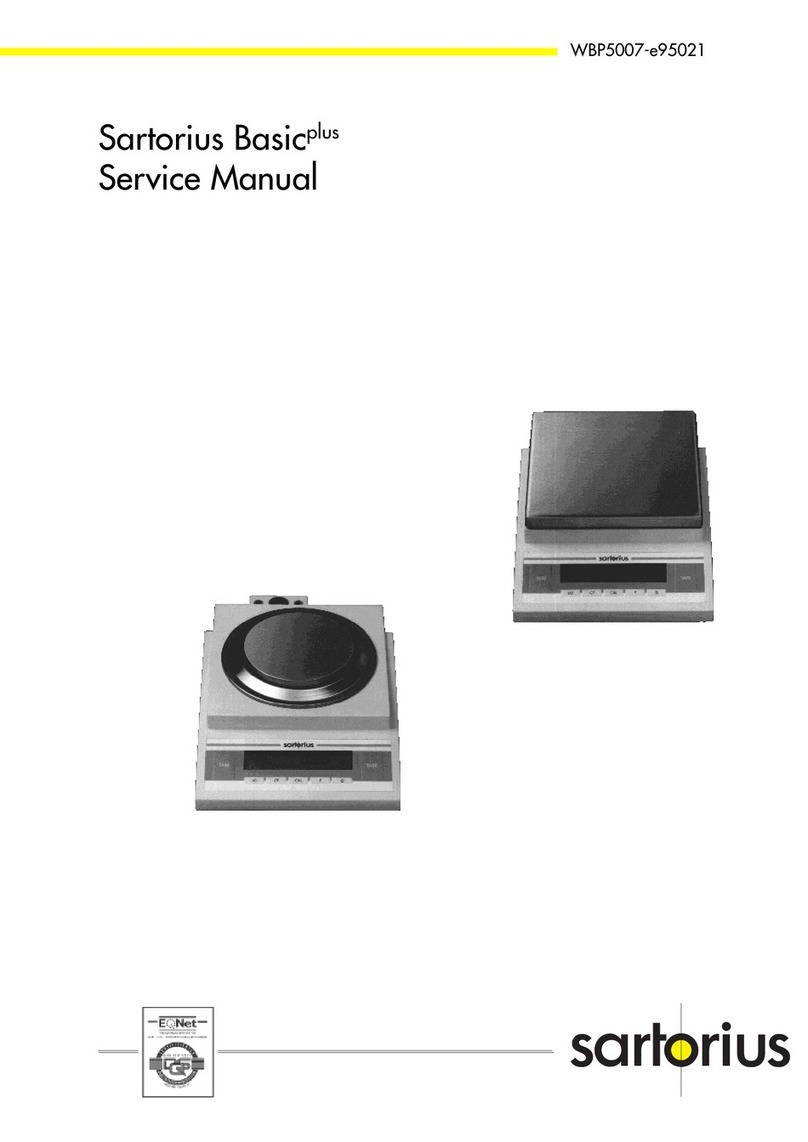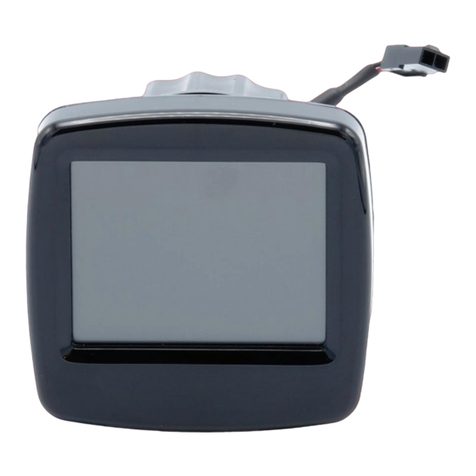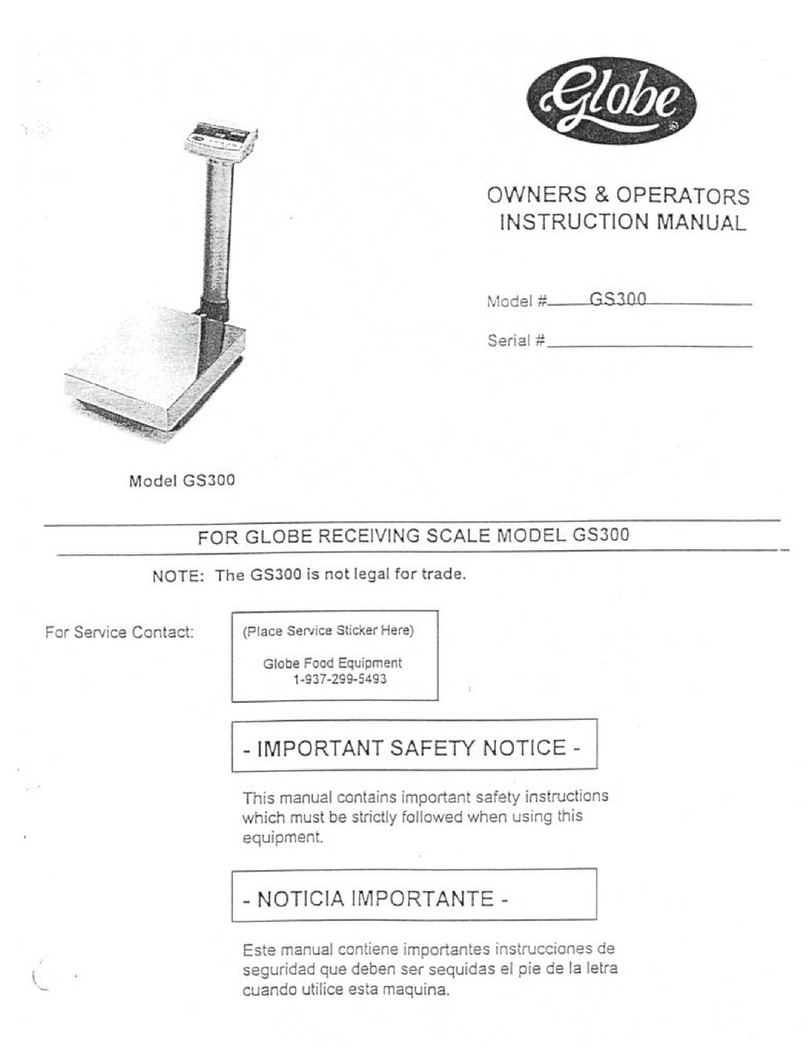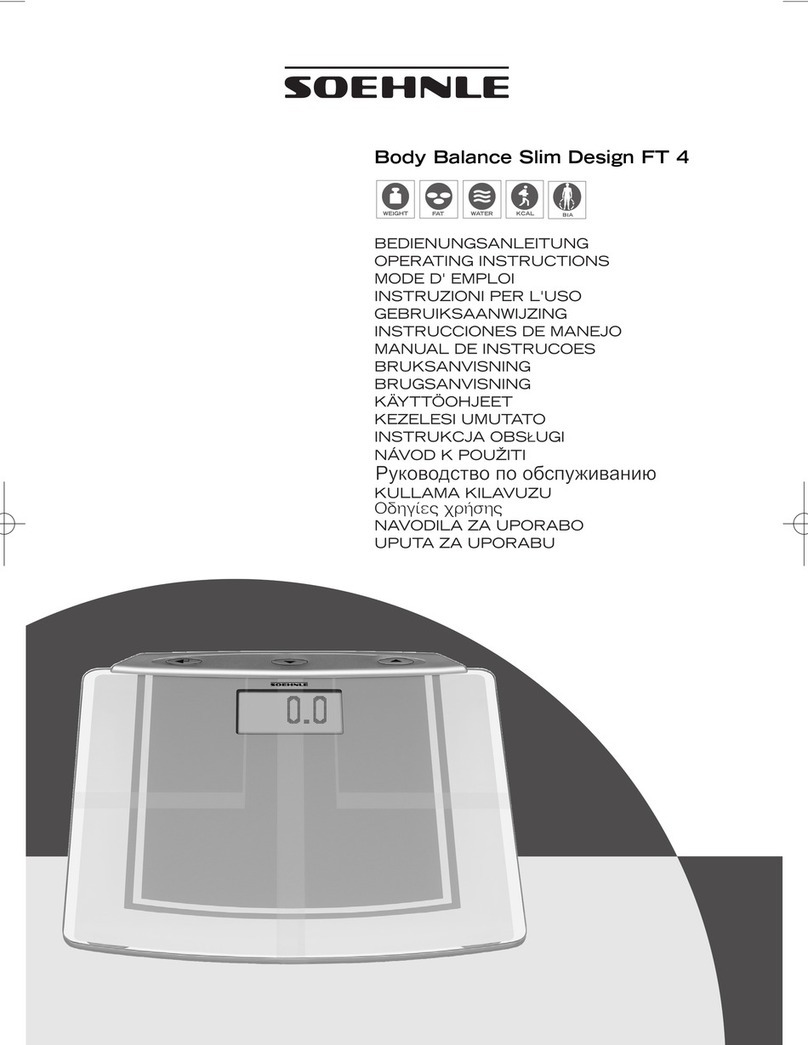WIKA CPB 3000 User manual

Operating Instructions
Betriebsanleitung
CPB 3000
Pressure Balance GB
Pressure Balance CPB 3000
Kolbenmanometer D

Pressure Balance GB
CPB 3000
WIKA Operating Instructions Pressure Balance Version 1.1 2
Information
This symbol provides you with information, notes and tips.
Warning!
This symbol warns you against actions that can cause injury to people or
damage to the instrument.
Operating Instructions Pressure Balance Page 4 - 27GB
Betriebsanleitung Kolbenmanometer Seite 28 - 53D

Pressure Balance GB
CPB 3000
WIKA Operating Instructions Pressure Balance Version 1.1 3
C
C
Co
o
on
n
nt
t
te
e
en
n
nt
t
ts
s
s
1. General ....................................................................................................................................... 4
1.1 General Instructions ................................................................................................................... 4
1.2 Safety Instructions ...................................................................................................................... 5
2. Product Description ...................................................................................................................... 6
2.1 General Product Information ..................................................................................................... 6
2.2 Basic principle of the Pressure Balance .................................................................................. 7
2.3 Factors at work ............................................................................................................................ 7
2.3.1 Local fluctuations in the gravity-value .................................................................................. 7
2.3.2 Temperature (Piston/Cylinder) ............................................................................................... 8
2.3.3 Ambient conditions .................................................................................................................. 8
2.3.4 How the cross-sectional surface responds to pressure ...................................................... 9
2.4 Arrangement of control elements ........................................................................................... 10
3. Commissioning and Operation .................................................................................................. 11
3.1 Preparation ................................................................................................................................ 11
3.1.1 Setting up the Device ............................................................................................................. 11
3.1.2 Filling in of operating liquid (first commissioning) ............................................................ 11
3.1.3 Installing the piston/cylinder system ................................................................................... 12
3.1.4 Connecting the test specimen .............................................................................................. 13
3.1.5 Venting the System ................................................................................................................ 13
3.2 Operation .................................................................................................................................. 15
3.2.1 Weight Pieces ......................................................................................................................... 15
3.2.2 Approaching the pressure value .......................................................................................... 16
3.2.3 Pressure stable ...................................................................................................................... 17
3.2.4 Next pressure level ................................................................................................................ 18
3.2.5 Releasing pressure ................................................................................................................ 18
3.3 Disassembly ..............................................................................................................................18
4. Troubleshooting measures ........................................................................................................ 20
5. Maintenance and Care ................................................................................................................ 21
5.1 Cleaning .................................................................................................................................. 21
5.1.1 Piston/Cylinder system ......................................................................................................... 21
5.1.1.1 Layout of the piston/cylinder system ............................................................................... 21
5.1.1.2 Disassembly of the piston/cylinder system ..................................................................... 21
5.1.1.3 Cleaning of the piston/cylinder system ............................................................................ 22
5.1.1.4 Assembly of the piston/cylinder system .......................................................................... 22
5.1.2 Weight Set ...............................................................................................................................22
5.2 Wear Parts ................................................................................................................................. 22
5.3 Changing the Hydraulic Oil ...................................................................................................... 23
5.4 Recalibration ............................................................................................................................. 23
6. Specifications .............................................................................................................................. 24
7. Tables of masses ........................................................................................................................ 26
7.1 Measuring ranges BAR ............................................................................................................. 26
7.2 Measuring ranges PSI ............................................................................................................... 26
8. Accessories ................................................................................................................................. 27

Pressure Balance GB
CPB 3000
WIKA Operating Instructions Pressure Balance Version 1.1 4
1. General .
1.1 General Instructions .
In the following chapters detailed information on the CPB 3000 pressure balance and its proper use
can be found.
Should you require further information, or should there be problems which are not dealt within detail in
the operating instructions, please contact the address below:
WIKA Alexander Wiegand SE & Co. KG
Alexander Wiegand Strasse
D-63911 Klingenberg
Tel: +49-(0)9372/132-473
Fax: +49-(0)9372/132-8767
If nothing to the contrary is agreed, the pressure balance is calibrated in compliance with the currently
valid body of international regulations and can be referred directly to a national standard.
The warranty period for the pressure balance is 24 months according to the general terms of supply of
ZVEI.
The guarantee is void if the appliance is put to improper use or if the operating instructions are not
observed or if an attempt is made to open the appliance or to release attachment parts or the tubing.
We also point out that the content of these operating instructions neither forms part of an earlier or
existing agreement, assurance or legal relationship nor is meant to change these. All obligations of
WIKA Alexander Wiegand SE & Co. KG result from the respective sales contract and the general
business terms of WIKA Alexander Wiegand SE & Co. KG.
WIKA is a registered trade mark of WIKA Alexander Wiegand SE & Co. KG.
Names of companies or products mentioned in this handbook are registered trade
marks of the manufacturer.
The devices described in this manual represent the latest state of the art in terms of their design,
dimension and materials. We reserve the right to make changes to or replace materials without any
obligation to give immediate notification.
Duplication of this manual in whole or in part is prohibited.
© 2010 Copyright WIKA Alexander Wiegand SE & Co. KG. All rights reserved.

Pressure Balance GB
CPB 3000
WIKA Operating Instructions Pressure Balance Version 1.1 5
1.2 Safety Instructions .
Read these operating instructions carefully prior to operating
the pressure balance CPB 3000. Its trouble-free operation and reliability cannot
be guaranteed unless the safety advise given in this manual is followed when
using the device.
1. The system must only be operated by trained and authorised personnel who know the manual and
can work according to them.
2. Trouble-free operation and reliability of the device can only be guaranteed so long as the
conditions stated under "Setting up the device" are taken into consideration.
3. The CPB 3000 always has to be handled with the care required for an precision instrument (protect
from humidity, impacts and extreme temperatures). The device, the piston-cylinder-system and the
mass-set must be handled with care (don't throw, hit, etc.) and protect them from contamination. By
no means apply any force to the operating elements of the CPB 3000.
4. If the device is moved from a cold to a warm environment, you should therefore ensure the device
temperature has adjusted to the ambient temperature before trying to put it into operation.
5. If the equipment is damaged and might no longer operate safely, then it should be taken out of use
and securely marked in such a way so that isn't used again.
Operator safety may be at risk if:
There is visible damage to the device
The device is not working as specified
The device has been stored under unsuitable conditions for an extended period of time.
If there is any doubt, please return the device to the manufacturer for repair or maintenance.
6. Customers must not attempt to alter or repair the device themselves. If the instrument is opened or
attachment parts are released, its trouble-free operation and reliability is impaired and endangers
the operator. Please return the device to the manufacturer for any repair or maintenance.
7. There must be used only the original sealings in the device.
8. Any operation not included in the following instructions or outside the specifications must not be
attempted.

Pressure Balance GB
CPB 3000
WIKA Operating Instructions Pressure Balance Version 1.1 6
2. Product Description .
2.1 General Product Information .
Application
Pressure balances are the most accurate instruments for the calibration of electronic or mechanical
pressure measuring instruments. The direct measurement of pressure, according to its definition as a
quotient of force and area, and the use of high-quality materials result in small uncertainties of
measurement and an excellent long-term stability of five years.
For these reasons pressure balances have already been used in calibration laboratories of industry,
national institutes and research labs for many years. Due to the integrated pressure generation and
the purely mechanical measuring principle the CPB 3000 is also ideally suited for on-site use as well
as service and maintenance purposes.
Piston/cylinder measuring system
Pressure is defined as a quotient of force and area. Correspondingly, the core of the CPB 3000 is a
very precisely manufactured piston/cylinder system. Both the piston and cylinder are manufactured
from Tungsten Carbide and are very well protected in a solid stainless steel housing against touching,
impacts or contamination from outside.
The entire construction design of the piston/cylinder unit and the very precise manufacturing of the
piston and the cylinder stand for excellent operating characteristics with a long free rotation time and
low fall rates and for a very high long term stability. Therefore the recommended re-calibration interval
is 5 years.
The hydraulic systems are available for measuring ranges from 60 bar up to 1,000 bar resp. 1,000 psi
up to 14,500 psi. The accuracy is 0.025 % of reading.
Functioning
In order to generate the individual test points, the piston cylinder system is weighted with mass-loads.
The weight applied is proportional to the desired pressure and provided by using optimally graduated
weights. These weights are manufactured to standard gravity (9.80665 m/s²) although for fixed
location usage they can be adjusted to a customer specified local gravity.
The pressure is set via an integrated fine-adjustable precision spindle pump. As soon as the
measuring system reaches equilibrium, there is a balance of forces between pressure and mass
applied.
Due to the high-grade quality of the system this pressure remains stable over several minutes, so that
for instance adjustments of your device under test can be carried out without any problems.

Pressure Balance GB
CPB 3000
WIKA Operating Instructions Pressure Balance Version 1.1 7
2.2 Basic principle of the Pressure Balance .
Their operating principle is based on the physical definition of pressure, the quotient of force and
surface.
Area
Force
essure =Pr
The key element of the pressure balance is a precision-manufactured piston/cylinder system with a
precisely measured cross-sectional surface.
To apply a pressure charge to the system, the piston is placed under a load with (calibrated) weight
pieces.
Each holding disk from the set of weights is identified by a nominal weight, which generates a
pressure value in the system (assuming standard reference conditions). Each weight has a number
and in the calibration certificate there is described the mass value to each weight with its resultant
pressure value. The weights are chosen according to the desired pressure value.
After that, the integrated spindle pump increases the pressure until the weights are in a floating state.
2.3 Factors at work .
The piston pressure gauge is calibrated to standard reference conditions when it leaves the factory
(depending on customer specifications).
If there are significant deviations between the application conditions and the defined reference
conditions, appropriate corrections must be made.
Following are the main factors that enter into play and must be considered.
These corrections can be made automatically with the CalibratorUnit CPU 5000
(see accessories point 8)!
2.3.1 Local fluctuations in the gravity-value .
The local force of gravitation is subject to major fluctuations caused by geographical variation.
The value may differ from one place on earth to another by as much as 0.5 %. Since this value has a
direct effect on the measurement, it is essential that it be taken into consideration.
The weight pieces can even be adjusted during manufacturing to match the location where they will be
used. Another option, especially if the device will be used at multiple locations, is to perform a
calibration to the standard gravity,
"Standard-g = 9.80665 m/s2".
Then a correction must be performed for each measurement according to the formula below:
gdardS sitenApplicatiog
pressureTrue −
−
⋅= tan
valueNominal
Example:
Local gravity set during manufacturing: 9.806650 m/s2
Locale gravity at application site: 9.811053 m/s2
Nominal pressure: 100 bar
True pressure: barbar
gg
pp
dardS
Local 0449.100
80665.9 81105.9
100
tan
Nominal ===
Without the correction, measurements would all be "off" by 0.05 %.

Pressure Balance GB
CPB 3000
WIKA Operating Instructions Pressure Balance Version 1.1 8
2.3.2 Temperature (Piston/Cylinder) .
The effective cross-sectional surface of the piston/cylinder system depends on the temperature.
The effect depends on the material used and is described by the temperature coefficient (TK).
In the event of deviations from standard reference conditions (typically 20°C), the following formula
must be used to make a correction:
()()
TKtt
pressureTrue
ferenceAppl ⋅−+
⋅=
Re
11
valueNominal
Example:
Reference temperature: 20°C
Temperature during use: 23°C
TK: 0.0022%
()
()
barbarpressureTrue 99340.99
2.220231 1
100 5=
⋅−+
⋅= −
Without the correction, measurements would all be "off" by 0.007 %.
2.3.3 Ambient conditions .
The effects of ambient conditions
air pressure
room temperature
relative humidity
should always be taken into consideration if the highest level of accuracy is required.
Fluctuations in ambient conditions change air density.
The air density affects the pressure through the buoyancy of the weights:
⎟
⎟
⎠
⎞
⎜
⎜
⎝
⎛−⋅= densityWeight
densityAir
Weight 1weightNominal
The air density is typically 1.2 kg/m3
The density of the weights (non-magnetic steel) is 7900 kg/m3
A fluctuation of 5% in the relative humidity causes an additional uncertainty in the measurement of
about 0.001%.

Pressure Balance GB
CPB 3000
WIKA Operating Instructions Pressure Balance Version 1.1 9
2.3.4 How the cross-sectional surface responds to pressure .
At higher pressures, the effective cross-sectional surface changes due to the pressure load.
The ratio of the cross-section and prevailing pressure is linear within an initial approximation. It is
represented by the coefficient of expansion caused by pressure distortion (λ).
pressureNominal1 pressureNominal
⋅+
=
λ
pressureTrue
Example:
Measuring point: 1000 bar
System with distortion coefficient: 10 –7 1/bar:
barbarpressureTrue 90.999
10001011 1000
7=
⋅
⋅
+
=−
Without the correction, measurements would all be "off" by 0.01 %.

Pressure Balance GB
CPB 3000
WIKA Operating Instructions Pressure Balance Version 1.1 10
2.4 Arrangement of control elements .
View from above
Front view
Side view
Connection for
test specimen
Spindle pump
Connection for
piston/cylinder
system
Water level
Removable star
handle with spring-
loaded thrust pad
Piston/cylinder
system
Rotating base
Reservoir with
Shut-off valve
Shut-off valve for
test connection
Storage for
weight pieces

Pressure Balance GB
CPB 3000
WIKA Operating Instructions Pressure Balance Version 1.1 11
3. Commissioning and Operation .
3.1 Preparation .
3.1.1 Setting up the Device .
Set up the pressure balance on a solid surface. If it is not resting on a solid foundation or is
subject to vibrations, measurements could be affected. This should be avoided.
If no temperature control system is present, the device should at least not be placed near a heat
element or window. This will reduce drafts and warm air flows as much as possible.
The water level should be used to align the device. At this time, rough alignment can already be
performed without the piston cylinder system. Using the rotating feed, position the device so that it
is horizontal.
Place the star handle with knobs onto the spindle pump. Ensure that the spring-loaded thrust pad
engages into the star handle bushing.
Remove the blind plugs from both pressure connections.
3.1.2 Filling in of operating liquid (first commissioning) .
As an operating liquid only the included hydraulic oil is suitable for the CPB
3000.
Other pressure transmitting media are available on request.
Fill the pressure balance with the operating liquid as follows:
Turn the spindle completely clockwise.
Open the shut-off valve of the reservoir and unscrew it completely, then remove the top cover of
the reservoir.
Pour the operating liquid carefully and slowly, alternating between both pressure connections. You
can monitor how the operating liquid settles into the reservoir. Pour the liquid into the pressure
connections until the reservoir is ½ to ¾ full.
Put the reservoir cap back on and fit the shut-off valve. However, leave the valve open!

Pressure Balance GB
CPB 3000
WIKA Operating Instructions Pressure Balance Version 1.1 12
3.1.3 Installing the piston/cylinder system .
The piston/cylinder system that is used depends on the device to be tested. You should select a
system with a comparable or higher range.
Example:
Calibration of a 600-bar pressure gauge Î600 bar Piston/cylinder system
Calibration of a 160-bar pressure gauge Î250 bar Piston/cylinder system
Before releasing the closure plug on the instrument base, make sure the system
is not under pressure (open the shut-off valve of the reservoir).
Before connecting the piston/cylinder system, the system should be vented. For this, oil is pumped
into the system by opening the left pressure connection by carefully turning the star handle in a
clockwise direction. It should be turned until oil appears at the O-ring seals of the open pressure
connection and no more air bubbles are escaping. The shut-off valve on the reservoir must be
closed. The shut-off valve of the test specimen connection must be opened and the blind plug must
be mounted into the test specimen connection.
Place the piston/cylinder system vertically in the left pressure connection, and firmly tightened
using a flat wrench with SW 32. An O-ring seal is already fitted, so no additional sealing material is
required.
Check the O-ring seal in the pressure connection for proper seat and for any
wear. Replace, if necessary (see chapter 8. Accessories).
For an exact alignment of the device, the water level may be removed from the basement plate and
placed on the top of the clamped piston/cylinder system. This will ensure the most accurate
referencing of the piston/cylinder system.
2.
3.
Here put on
water level
1.
O-ring
(see accessories section 8.)

Pressure Balance GB
CPB 3000
WIKA Operating Instructions Pressure Balance Version 1.1 13
3.1.4 Connecting the test specimen .
Before connecting the piston/cylinder system, the system should be vented. For this, oil is pumped
into the system by opening the right pressure connection by carefully turning the star handle in a
clockwise direction. It should be turned until oil appears at the O-ring seals of the open pressure
connection and no more air bubbles are escaping. The shut-off valve on the reservoir must be
closed. The shut-off valve of the test specimen connection must be opened and the piston/cylinder
system must be mounted into the piston/cylinder system connection.
Place the device to be checked in the quick connector with the knurled nut. It can be freely
positioned. Hand-tightening will suffice for safe sealing.
To calibrate instruments with back pressure entry there is an angle connection 90°available (see
accessories section 8).
Check the O-ring seal in the test specimen connection for proper seat and for
any wear. Replace, if necessary.
Please see to it, that each instrument mounted to the pressure balance must be
clean inside.
The quick connector comes equipped with a G 1/2 threaded insert in the standard delivery
package.
When you are calibrating devices with different connection threads, the threaded
inserts can be changed as appropriate (see accessories "Adapter Set").
3.1.5 Venting the System .
After the filling in of operating liquid and after the clamping of the piston/cylinder system and the test
specimen, further air may be trapped in the system. The system may be vented before beginning with
calibration using the following procedure:
The reservoir cap must be put back on and the shut-off valve of the reservoir must be mounted.
However, leave the valve open!
The piston/cylinder system and test specimen must be clamped, and the complete weight set must
be placed on the piston/cylinder system.
1) Close the shut-off valve for test connection (2) by turning it clockwise.
2) Open the shut-off valve on the reservoir (3).
3) Turn the star handle (1) anticlockwise until fully out/open.
Pressure medium is drawn from the reservoir into the cylinder of the pump.
4) Close the shut-off valve on the reservoir (3).
5) Open the shut-off valve for test connection (2) by turning it counterclockwise
(less than one complete turn is sufficient).
O-ring 8 x 2
(see accessories section 8.)
Knurled nut

Pressure Balance GB
CPB 3000
WIKA Operating Instructions Pressure Balance Version 1.1 14
6) Turn the star handle (1) clockwise until the test specimen indicates a pressure of
appro. 50 to 100 bar.
If the connected instrument has still not been filled enough or if the required pressure
has still not been reached, repeat steps 1) to 6) until the test specimen indicates a
pressure of appro. 50 to 100 bar.
7) Increase the pressure with the spindle pump further until just below the final value of the value
range of the ConTect system, or of the test specimen (the smaller pressure range is the decisive
factor).
Important: The piston/cylinder system must remain in its lower position for this
operation, i.e. not yet moving into equilibrium.
8) Open the shut-off valve on the reservoir (3), any trapped air will escape into the tank.
Repeat steps 1) to 8) several times in order to remove all trapped air.
The device is now ready to use.
(1) Star handle
(2) Shut-off valve for test connection
(3) Shut-off valve for reservoir
(4) Test specimen
(5) Piston/cylinder system
(1)
(3)
(2)
(4)
(5)

Pressure Balance GB
CPB 3000
WIKA Operating Instructions Pressure Balance Version 1.1 15
3.2 Operation .
3.2.1 Weight Pieces .
First of all put the bell onto the piston/cylinder system.
Stack the weight pieces onto the bell depending on the pressure value that is required.
It is usually best to start with the heaviest weight so that the centre of gravity is as low as possible.
Each component is identified by a consecutive number. In the calibration certificate to each number
the resultant pressure assuming reference conditions is listed.
Example table from a calibration certificate page 2:
Druckwerte der Gewichtsstücke / Pressure values of masses
Bezeichnung des
Gewichtsstückes
type of weight piece
Nr.
no. wahre Masse
true mass
in kg
Druckwert
für System
pressure value
for system
in bar
Kolben / piston 1262 0.08160 0.4002
Glocke / bell 1 0.81560 3.9998
Teller / plate 2 0.05097 0.2499
Masse / weight piece 3 1.01954 5.0000
Masse / weight piece 4 1.01954 5.0000
Masse / weight piece 5 1.01954 5.0000
Masse / weight piece 6 1.01954 5.0000
Masse / weight piece 7 1.01954 5.0000
Masse / weight piece 8 1.01954 5.0000
Masse / weight piece 9 1.01954 5.0000
Masse / weight piece 10 1.01953 5.0000
Masse / weight piece 11 1.01952 4.9999
Masse / weight piece 12 0.50976 2.5000
Masse / weight piece 13 0.20391 1.0000
Masse / weight piece 14 0.20391 1.0000
Masse / weight piece 15 0.12234 0.6000
Masse / weight piece 16 0.10196 0.5000
Masse / weight piece 17 0.07137 0.3500
Masse / weight piece 18 0.05098 0.2500
Example: weight piece no. 5 generates a pressure value of 5.0000 bar
with its weight value of 1.01954 kg assuming reference
conditions (room temperature 20°C, air pressure1013 mbar,
relative humidity 40 %)
The pressure that will be achieved thus corresponds to the sum of the basic weight (piston), the
bell and the weight rings.
To reduce the starting value, the weight plate (No. 2) can be used as the basic holding surface
instead of the bell (No. 1).

Pressure Balance GB
CPB 3000
WIKA Operating Instructions Pressure Balance Version 1.1 16
.Weight pieces with bell . . Weight pieces with plate ..
3.2.2 Approaching the pressure value .
We recommend unscrewing the spindle pump completely when you start to record measurement
values, (turning anticlockwise) to allow enough volume for measurements. The shut-off valve for
the test connection (2) must be closed and the shut-off valve on the reservoir (3) must be opened
during this process.
After this close the shut-off valve on the reservoir (3) and open the shut-off valve for the test
connection (2).
To increase the test pressure turn the star handle (1) clockwise.
If, after the spindle has been fully wound in in a clockwise direction, there is no
increase in pressure, then the connected test volume is not yet filled enough and new
pressure medium must be drawn from the reservoir into the test specimen. For this
purpose, proceed as follows:
1) Close the shut-off valve for test connection (2) by turning it clockwise.
2) Open the shut-off valve on the reservoir (3).
3) Turn the star handle (1) anticlockwise until fully out/open.
Pressure medium is drawn from the reservoir into the cylinder of the pump.
4) Close the shut-off valve on the reservoir (3).
5) Open the shut-off valve for test connection (2) by turning it counterclockwise
(less than one complete turn is sufficient).
6) Turn the star handle (1) clockwise until the test specimen and/or the reference indicates a
pressure of appro. 10 to 50 bar (depending on the measuring range).
Piston/cylinder
s
y
stem
Bell (No. 1)
Plate (No. 2)
Weight
p
ieces
Marking line for
float
p
osition

Pressure Balance GB
CPB 3000
WIKA Operating Instructions Pressure Balance Version 1.1 17
If the connected instrument has still not been filled enough or if the required pressure
has still not been reached, repeat steps 1) to 6) until the test specimen indicates the
appropriate pressure.
(1) Star handle
(2) Shut-off valve for test connection
(3) Shut-off valve for reservoir
(4) Test specimen
(5) Piston/cylinder system
3.2.3 Pressure stable .
Continue admitting pressure until the system is in a state of equilibrium.
In this case the lower edge of the bell must stay at the position of the marking line of the
piston/cylinder system.
Marking line for float
position
Lower edge of the
bell
(1)
(3)
(2)
(4)
(5)

Pressure Balance GB
CPB 3000
WIKA Operating Instructions Pressure Balance Version 1.1 18
Just before the float position, the system increases quickly.
We therefore recommend turning the spindle slowly and evenly clockwise.
To minimise the effect of friction, move the system up against the weight pieces carefully and make
a turning movement.
Never move the system up and make a turning movement, if the piston is in the
lower or upper block position.
The piston and thus the test pressure as well now remain stable for several minutes.
3.2.4 Next pressure level .
To adjust to the next highest pressure, repeat the previous steps from 3.2.1 to 3.2.3
3.2.5 Releasing pressure .
Turn the spindle pump anticlockwise to release pressure in the system.
If the pressure is close to the next test level, make the fine adjustment with the spindle wheel.
To release pressure more quickly or for venting, the shut-off valve for reservoir can also be
carefully opened.
Attention: In this case the piston must stay in the lower position!
Caution:
The piston is lowered very quickly just before equilibrium is achieved.
3.3 Disassembly .
After all pressure points have been recorded, open the shut-off valve for the reservoir.
Now the test specimen can be removed from the quick clamp and if required also the
piston/cylinder system can be disconnected from the pressure connection. The piston/cylinder
system should then be stored in its protective container.
Do not disconnect the test specimen or the piston/cylinder system until the
pressure in the pressure balance has been completely released.
Close both pressure connections with the blind plugs again.

Pressure Balance GB
CPB 3000
WIKA Operating Instructions Pressure Balance Version 1.1 19
In order to remove the star handle from the spindle pump, the spring-loaded thrust pad must be
pressed downward with the aid of a small screwdriver, or a ball-point pen. The star handle may
now be pulled off toward the front.
In case of transporting the instrument the operating liquid should be drawn out of the reservoir e.g.
with a suitable syringe (for this also see section 5.3 Removing hydraulic oil).
Spring-loaded
thrust pad

Pressure Balance GB
CPB 3000
WIKA Operating Instructions Pressure Balance Version 1.1 20
4. Troubleshooting measures .
If faults cannot be repaired, the system must be put out of operation
immediately and this information is to be given to the manufacturer.
Repairs must only be carried out by the manufacturer. Interventions and
changes on the appliance are not allowed.
In case of faults caused by defects of the hydraulic equipment the operators must inform their
superiors immediately and call in the qualified and authorised technical staff for maintenance.
Table: Fault description and measures .
Type of fault Measures
I. Unable to build up pressure / leak in the system
Close shut-off valve for the reservoir
correctly
Check whether the seals have been
placed in the pressure connections and
whether they are properly positioned.
II. Unable to build up pressure, or range cannot
be reached
After the clamping of the piston/cylinder
system and the test specimen, air may be
trapped in the system.
Please note: The system should be
vented before beginning with calibration.
For this purpose, proceed according to
section 3.1.5.
Afterwards, build the pressure back up.
If, after the spindle has been fully wound
in in a clockwise direction, there is no
increase in pressure, then the connected
test volume is not yet filled enough and
new pressure medium must be drawn
from the reservoir into the test specimen.
For this purpose, proceed according to
section 3.2.2.
III. Slow lowering of the piston in equilibrium
Leak in the system, see fault I.
After the clamping of the piston/cylinder
system and the test specimen, air may be
trapped in the system, see point II.
Afterwards, build the pressure back up.
IV. Piston is not turning or does not respond
readily
Attention: If the piston is not turning
easily or "squeaks", do not under any
circumstances force it to turn. Doing so
could cause lasting damage that would
seriously affect measurement properties.
The piston must be cleaned (see section
5.1.1)
Further help can be found through WIKA's Calibration Technology Department.
Table of contents
Languages:
Other WIKA Scale manuals

